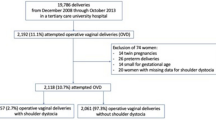Abstract
Objective
To examine the course and outcome of deliveries occurring in women who previously experienced shoulder dystocia. In addition, recurrent shoulder dystocia risk factors were assessed.
Methods
A retrospective cohort analysis comparing all singleton deliveries with and without shoulder dystocia in their preceding delivery was conducted. Independent predictors of recurrent shoulder dystocia were investigated using a multiple logistic regression model.
Results
Of the 201,422 deliveries included in the analysis, 307 occurred in women with a previous shoulder dystocia (0.015 %). Women with a history of shoulder dystocia were more likely to be older, experienced higher rates of gestational diabetes mellitus, polyhydramnios, prolonged second stage, operative delivery and macrosomia (>4000 g) in the following delivery. Previous shoulder dystocia was found to be an independent risk factor for recurrent shoulder dystocia (OR = 6.1, 95 % CI 3.2–11.8, p value <0.001) in the multivariable regression analysis.
Conclusions
Shoulder dystocia is an independent risk factor for recurrent shoulder dystocia. Deliveries in women with a history of shoulder dystocia are characterized by higher rates of operative delivery, prolonged second stage of labor and macrosomia.
Similar content being viewed by others
References
Spong CY, Beall M, Rodrigues D, Ross MG (1995) An objective definition of shoulder dystocia: prolonged head-to-body delivery intervals and/or the use of ancillary obstetric maneuvers. Obstet Gynecol 86(3):433–436
Gherman RB (2002) Shoulder dystocia: an evidence-based evaluation of the obstetric nightmare. Clin Obstet Gynecol 45(2):345–362
Gherman RB, Ouzounian JG, Goodwin TM (1999) Brachial plexus palsy: an in utero injury? Am J Obstet Gynecol 180(5):1303–1307
Chauhan SP (2014) Shoulder dystocia and neonatal brachial plexus palsy: eliminating the nightmare. Semin Perinatol 38(4):183
Coroneos CJ, Voineskos SH, Coroneos MK, Alolabi N, Goekjian SR, Willoughby LI, Farrokhyar F, Thoma A, Bain JR, Brouwers MC (2015) Obstetrical brachial plexus injury: burden in a publicly funded, universal healthcare system. J Neurosurg Pediatr 23:1–8
Leung TY, Stuart O, Suen SSH, Sahota DS, Lau TK, Lao TT (2011) Comparison of perinatal outcomes of shoulder dystocia alleviated by different type and sequence of manoeuvres: a retrospective review. BJOG 118(8):985–990
Clark SL, Belfort MA, Dildy GA, Meyers JA (2008) Reducing obstetric litigation through alterations in practice patterns. Obstet Gynecol 112(6):1279–1283
Tsur A, Sergienko R, Wiznitzer A, Zlotnik A, Sheiner E (2012) Critical analysis of risk factors for shoulder dystocia. Arch Gynecol Obstet 285(5):1225–1229
Hope P, Breslin S, Lamont L et al (1998) Fatal shoulder dystocia: a review of 56 cases reported to the confidential enquiry into stillbirths and deaths in infancy. Br J Obstet Gynaecol 105(12):1256–1261
Secher AL, Bytoft B, Tabor ANN, Damm P, Mathiesen ER (2015) Fetal sonographic characteristics associated with shoulder dystocia in pregnancies of women with type 1 diabetes. Acta Obstet Gynecol Scand 94(10):1105–1111
Boulvain M, Senat M-V, Perrotin F et al (2015) Induction of labour versus expectant management for large-for-date fetuses: a randomised controlled trial. Lancet 385(9987):2600–2605
Sheiner E, Levy A, Hershkovitz R et al (2006) Determining factors associated with shoulder dystocia: a population-based study. Eur J Obstet Gynecol Reprod Biol 126(1):11–15
Chauhan SP, Laye MR, Lutgendorf M et al (2014) A multicenter assessment of 1,177 cases of shoulder dystocia: lessons learned. Am J Perinatol 31(5):401–406
Klein J, Charach R, Sheiner E (2015) Treating diabetes during pregnancy. Expert Opin Pharmacother 16(3):357–368
Levy A, Sheiner E, Hammel RD et al (2006) Shoulder dystocia: a comparison of patients with and without diabetes mellitus. Arch Gynecol Obstet 273(4):203–206
Usta IM, Hayek S, Yahya F, Abu-Musa A, Nassar AH (2008) Shoulder dystocia: what is the risk of recurrence? Acta Obstet Gynecol Scand 87(10):992–997
Ouzounian JG, Gherman RB, Chauhan S, Battista LR, Lee RH (2012) Recurrent shoulder dystocia: analysis of incidence and risk factors. Am J Perinatol 29(7):515–518
Bingham J, Chauhan SP, Hayes E, Gherman R, Lewis D (2010) Recurrent shoulder dystocia: a review. Obstet Gynecol Surv 65(3):183–188
Overland EA, Spydslaug A, Nielsen CS, Eskild A (2009) Risk of shoulder dystocia in second delivery: does a history of shoulder dystocia matter? Am J Obstet Gynecol 200(5):506.e1–506.e6
Osterman MJK, Martin JA (2014) Trends in low-risk cesarean delivery in the United States, 1990–2013. Natl Vital Stat Rep. 63(6):1–16
Faschingbauer F, Dammer U, Raabe E, Schneider M, Faschingbauer C, Schmid M, Schild RL, Beckmann MW, Kehl S, Mayr A (2015) Intrapartum sonographic weight estimation. Arch Gynecol Obstet 292(4):805–811
Froehlich R, Simhan HN, Larkin JC (2015) An evidence-based approach to defining fetal macrosomia. Am J Perinatol 33(5):456–462
Cordero L, Paetow P, Landon MB, Nankervis CA (2015) Neonatal outcomes of macrosomic infants of diabetic and non-diabetic mothers. J Neonatal Perinat Med 8(2):105–112
Ginsberg NA, Moisidis C (2001) How to predict recurrent shoulder dystocia. Am J Obstet Gynecol 184(7):1427–1429 (discussion 1429–1430)
Lewis DF, Raymond RC, Perkins MB, Brooks GG, Heymann AR (1995) Recurrence rate of shoulder dystocia. Am J Obstet Gynecol 172(5):1369–1371
Langer O, Berkus MD, Huff RW, Samueloff A (1991) Shoulder dystocia: should the fetus weighing greater than or equal to 4000 g be delivered by cesarean section? Am J Obstet Gynecol 165(4 Pt 1):831–837
Hansen A, Chauhan SP (2014) Shoulder dystocia: definitions and incidence. Semin Perinatol 38:184–188
Mehta SH, Sokol RJ (2014) Shoulder dystocia: risk factors, predictability, and preventability. Semin Perinatol 38(4):189–193
Ouzounian JG (2014) Risk factors for neonatal brachial plexus palsy. Semin Perinatol 38(4):219–221
Gemer O, Bergman M, Segal S (1999) Labor abnormalities as a risk factor for shoulder dystocia. Acta Obstet Gynecol Scand 78:735–736
McFarland M, Hod M, Piper JM, Xenakis EM-J, Langer O (1995) Are labor abnormalities more common in shoulder dystocia? Am J Obstet Gynecol 173(4):1211–1214
Author information
Authors and Affiliations
Corresponding author
Ethics declarations
Funding
This study has no funding.
Conflict of interest
The authors declare that they have no conflict of interest.
Ethical approval
This article does not contain any studies with human participants or animals performed by any of the authors.
Rights and permissions
About this article
Cite this article
Kleitman, V., Feldman, R., Walfisch, A. et al. Recurrent shoulder dystocia: is it predictable?. Arch Gynecol Obstet 294, 1161–1166 (2016). https://doi.org/10.1007/s00404-016-4139-1
Received:
Accepted:
Published:
Issue Date:
DOI: https://doi.org/10.1007/s00404-016-4139-1




